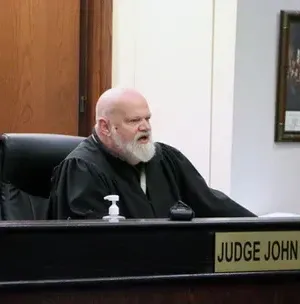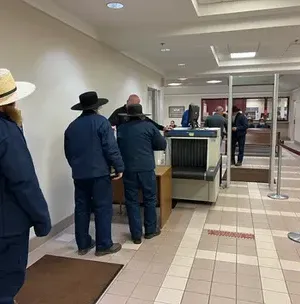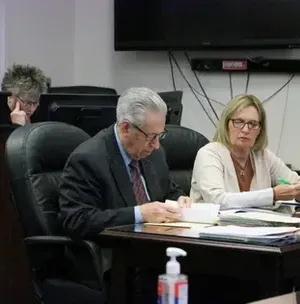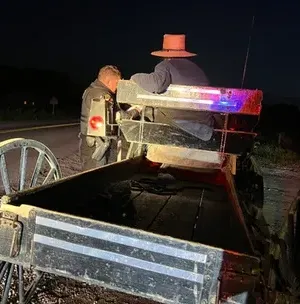 In a significant ruling, Honorable Judge John L. Good of the Ashland Municipal Court has denied to dismiss previous cases against Amish residents in Ashland County who challenged the constitutionality of the Ohio Buggy light law. All four Defendants who were unrepresented by Counsel argued that the law, which requires all horse-drawn vehicles to have a flashing yellow light visible from a distance, violates their fundamental right to freedom of religion.
In a significant ruling, Honorable Judge John L. Good of the Ashland Municipal Court has denied to dismiss previous cases against Amish residents in Ashland County who challenged the constitutionality of the Ohio Buggy light law. All four Defendants who were unrepresented by Counsel argued that the law, which requires all horse-drawn vehicles to have a flashing yellow light visible from a distance, violates their fundamental right to freedom of religion.
Honorable Judge John L. Good
The Background of the Case:
The defendants, Emery Troyer, Dan Troyer, Andrew Slabaugh, and Jacob Gingerich, are members of the Old Order Amish sects within Ashland County. They share the same religious beliefs and have been charged with violations of the Ohio Buggy light law. These individuals raised objections to the law, claiming that it infringes upon their right to freely exercise their religion under the First and Fourteenth Amendments of the U.S. Constitution and under Article 1, Section 7 of the Ohio Constitution.
The Defendants’ Testimony:
During the evidentiary hearing, all four defendants testified about their religious objections to the statute. They explained that their objections were based on sincere religious beliefs rather than mere cultural practices. According to their testimonies, they believe that their faith requires them to honor the traditions and practices of their ancestors, which include the use of dark clothing and unlit buggies. Bright colors and flashing lights go against their religious beliefs. The defendants also highlighted the potential consequences of complying with the law, such as being shunned by their community.
The state presented testimony
The State, represented by Rep. Scott Wigham, presented extensive testimony regarding the legislative process that led to the enactment of Senate Bill 30, now known as Section 4513.114. Rep. Wigham, who was a primary sponsor of the bill, described the years-long collaboration between the General Assembly, various Amish groups, and public safety officials. The goal was to address the alarming number of car on buggy crashes while minimizing the impact on Amish religious practices.
The Problem of Car on Buggy Crashes
Contrary to popular belief, the majority of car on buggy crashes occur during the day and on straight sections of road. Most often, these accidents happen on State Routes where motorists are traveling at high speeds. The primary cause of these crashes is the significant speed differential between motor vehicles and horse-drawn buggies. Motorists have only a few seconds to recognize a buggy ahead and slow down. With distractions, speeding, impairment, or lack of attention, the window for reaction closes even tighter.
The Rationale Behind the Flashing Yellow Light Requirement
To help motorists identify buggies more quickly, Section 4513.114(B)(1) requires the use of flashing yellow lights on Amish buggies. The State has determined that yellow is a color associated with caution, prompting motorists to instinctively reduce their speed. Unlike reflective tape, slow-moving vehicle signs, reflectors, and lanterns, which are only effective at night, flashing yellow lights are visible during daylight conditions when most car on buggy crashes occur.
The Impact of the Yellow Light Requirement
The effectiveness of the flashing yellow light requirement is evident in the reduction of car on buggy crashes. Lt. Bishop of the Ashland OSP post testified that between August 31, 2022 (when the legislation came into effect) and the date of the Court’s hearing, there was a 22% decline in car-buggy crashes in Ohio compared to previous years. This significant reduction is attributed to the enactment of Section 4513.114(B)(1).
Religious Objections and Constitutional Protections
The defendants in the case, who are members of the Amish community, raised sincere religious objections to the flashing yellow light requirement. The Court recognized the legitimacy of these objections, as they were rooted in deeply held religious beliefs. Furthermore, the Court acknowledged that the privilege to travel on public roads, impacted by the requirement, is an important one for the defendants. The ability to travel is necessary for the Amish to practice their religious ceremonies and meetings.
Balancing Religious Liberty and Public Safety
While religious liberty is a fundamental right protected by both the United States and Ohio Constitutions, it is not absolute. The Court applied the three-part test established by the United States Supreme Court to determine the constitutionality of Section 4513.114(B)(1). It found that the burden imposed on the defendants’ right to freely exercise their religious beliefs was justified by a compelling state interest: reducing the number of car on buggy accidents in Ohio. The flashing yellow light requirement was deemed the least restrictive method to achieve this compelling interest.
Conclusion
Judge John L. Good’s ruling in this landmark case sets an important precedent for the balance between religious freedom and public safety. By carefully considering the sincere religious beliefs of the defendants and the compelling state interest to reduce car on buggy crashes, the Court struck a delicate balance. Section 4513.114(B)(1) and its requirement of flashing yellow lights on Amish buggies have proven to be an effective means of promoting public safety while respecting the religious practices of the Amish community.
Previous Story:
Amish Buggy Light Law: Unveiling the Verdict that Could Shape a Community and Legislation
















